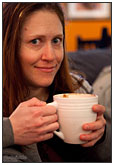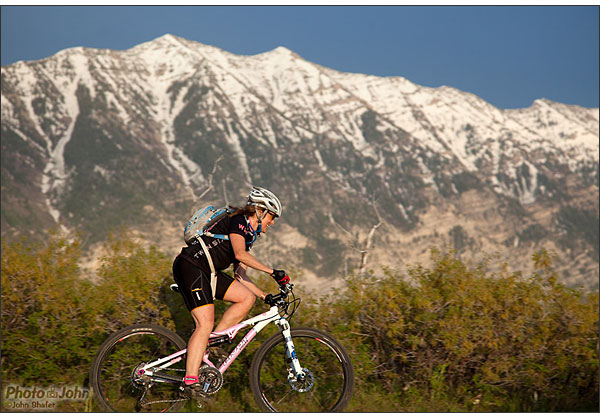Canon EOS 5D Mark II Camera Experience
 When Canon sent me the EOS 5D Mark II I was most interested in the video capture. But I quickly found that the real strength of the 5D Mk II is low-light photography. Yeah, the video is great. But it’s still a digital SLR and although I make a few videos I’m a photographer, not a videographer. Right away I tried shooting at ISO 800, then 1600, and even 3200. I was amazed at the low noise and detail. Combined with the image-stabilized EF 24-105mm f/4L IS lens (you can buy the 5D Mk II as a kit with this lens), you can absolutely shoot at night with the 5D Mk II and get usable images. Handheld ISO 3200 portraits in a dark coffee house came out beautifully. Noise was visible but it wasn’t distracting or offensive. Really usable ISO 3200 – that’s awesome! Even better for me, the excellent low-light image quality means I can use high ISO settings for mountain bike photos at sunset or in dimly lit forest. Better low-light image quality means getting the shot in more conditions and that’s a very big deal. It makes the EOS 5D Mk II a very, very flexible camera.
When Canon sent me the EOS 5D Mark II I was most interested in the video capture. But I quickly found that the real strength of the 5D Mk II is low-light photography. Yeah, the video is great. But it’s still a digital SLR and although I make a few videos I’m a photographer, not a videographer. Right away I tried shooting at ISO 800, then 1600, and even 3200. I was amazed at the low noise and detail. Combined with the image-stabilized EF 24-105mm f/4L IS lens (you can buy the 5D Mk II as a kit with this lens), you can absolutely shoot at night with the 5D Mk II and get usable images. Handheld ISO 3200 portraits in a dark coffee house came out beautifully. Noise was visible but it wasn’t distracting or offensive. Really usable ISO 3200 – that’s awesome! Even better for me, the excellent low-light image quality means I can use high ISO settings for mountain bike photos at sunset or in dimly lit forest. Better low-light image quality means getting the shot in more conditions and that’s a very big deal. It makes the EOS 5D Mk II a very, very flexible camera.
The 22-megapixel sensor and big pixels mean low noise at high ISO settings and that means you can shoot at faster shutter speeds to freeze action or just get good results in low light. And the high-resolution files are great if you need to print big or impress a publisher. But there’s a price to pay for that resolution – the 22-megapixel files are huge! The 5D Mark II can shoot JPEGs until the card is filled but if you’re shooting RAW bursts are limited to 14 frames. I missed some action shots because the buffer filled faster than I expected, forcing the camera to stop shooting and save to the card. The huge files also mean you’ll need more memory cards and more hard drive space. It’s important to ask yourself if you really need the image quality that the 5D Mk II offers. Yes, it produces wonderful image quality in all kinds of situations. But personally, I rarely need that kind of quality. I benefit from the extra performance of the 5D Mk II in maybe 5% of the shooting situations I encounter. Add a flash to compensate for low light and I probably only “need” the performance of the 5D Mk II about 1% of the time. And that brings me to my next issue with the camera – weight.
Most of the shooting that’s really important to me happens on the trail. The size and weight of my camera gear is very important to me. If I only shot on the street or in the studio it wouldn’t matter. But every gram counts when I’m on my bike. I can ride my mountain bike with the EOS 5D Mark II – I did a decent-sized ride carrying the 5D, 70-200mm f/2.8L, 24-105mm f/4L IS, fisheye, 550 EX flash and PocketWizard radio slaves. But that took a huge toll on my body. I’m always looking for the best compromise between size/weight and image quality/performance. The 5D Mk II produces beautiful images but it just isn’t worth it for me to carry it on the bike. I can get magazine- quality images from much lighter, smaller and less expensive cameras. Lighter means I ride farther and get more pictures and that’s what really counts.
One thing that concerned me about the 5D Mark II was the auto focus system. For the most part it’s the same as the original 5D and theoretically that puts it behind other current digital SLRs. For that reason I was nervous about using the 5D Mk II in Canon’s AI Servo continuous auto focus mode. But in a controlled comparison with the EOS 50D, which has a more sophisticated auto focus system, (cars passing at 40 miles-per hour, AI Servo, center AF point, 70-200 f/2.8L and 24-105mm f/4L IS) the 5D Mk II performed better than I expected. After careful comparison I think the 5D Mark II’s auto focus is close to or as good as the 50D’s. If you’re shooting a lot of action, the 50D’s faster frame rate, fresher AF system and considerably lower price make it a better choice for many photographers. And if perfect auto focus is your top priority, you’d better go with the EOS-1D Mark III or EOS-1Ds Mark III. Auto focus on the 1D cameras is a world apart from other Canon bodies.
Canon EOS 5D Mark II Video
I’m not a video guy but I’ve found myself shooting more and more video to compliment camera reviews and tradeshow coverage. At first I just shot them with whatever point-and-shoot camera was convenient. Then we tested the Canon EOS 5D Mark II and I realized there really was a quality difference. When 5D Mark II video samples started appearing online the hype definitely sucked me in. I talked to Canon about the 5D Mk II at PMA and the majority of the conversation was about video. There was no doubt about the 5D Mk II’s potential video quality – that was proven as soon as it was available. But I was curious about how viable a “VSLR” is for professional video, how user-friendly the camera would be for regular folks, and whether a still photographer like me would be able to jump in and make decent videos.
I discovered that video has a very steep learning curve. Still photographers know a lot about camera, composition and exposure. But that experience doesn’t easily transfer over to video. It’s easy enough to pick up the camera, take a quick look at the manual and capture some video. But actually making something watchable is a challenge for an average guy like me. First of all, there’s no auto focus in the video mode with the 5D Mk II, or any other video-enabled digital SLR. The auto focus sensors in a digital SLR are on the mirror and the mirror has to be locked-up for Live View / video mode. That means focusing is manual-only and you really have to plan and pre-focus your shots if you want them to be sharp. Don’t expect to be able to handhold the camera and focus manually while you’re shooting, either. It’s not gonna work.
The biggest problem for me was editing my video clips. It’s a lot easier if you’re a Mac user because the 5D Mark II’s .MOV files can easily be opened and edited with Apple’s free iMovie software. But we’re not all Mac users and the Windows Movie Maker software that comes with a PC cannot edit the 5D Mk II video files. I’m not sure why Canon chose to use the .MOV format; perhaps the final quality is better. In any case, if you’re a PC owner, be aware that you won’t be able to take the camera out of the box, shoot a few video clips and immediately assemble them into an award-winning video. I ended up buying Adobe Premiere Elements ($99.99 US) so I could edit my 5D Mk II videos. Then you have to learn the software. If you’re a still photographer, video technique and workflow is different from what you’re used to and you should expect some frustration. However, when you do get it figured out, you can expect really beautiful video quality from the 5D Mk II.
next page – Canon EOS 5D Mark II Image Quality >>
|




A few remarks about your review. You say it is possible to shoot in the dark with the Mark II and a 24-105 f4 at ISO 3200. That may be true but people should consider that f4 is three stops slower than 1.4 wich means you can shoot using the same shutter speed at ISO 400. You can do that with any camera.
And it depends on your subjects of course but flash (or extra lights) will always be needed. Maybe not to light the whole picture but certainly to change the light balance within the picture.
Finally, you may think it is heavy but it is actually 20% lighter than the D700. So you can also say it is relatively light.
Amedi-
Thanks for commenting. Very true that the 5D Mk II is lighter than some other pro cameras. That’s a good perspective to add. It’s definitely lighter than the Canon EOS-1D cameras. Personally, I am always trying to go as light as possible when I’m in the backcountry. And that’s why I said the 5D Mk II is heavy. It’s also a much coveted camera for people just starting to work as pro photographers. And some of those people will be surprised at the weight. But if you’re workiing in the studio or on the street the weight shouldn’t be an issue. It’s only an issue for me when I’m on my mountain bike.
Regarding “shooting in the dark” – I may have been a little overexuberant there
It’s true that a faster lens will always offer better image quality because it collects more light. But the flexibility of the 24-10f f/4L zoom is really, really nice. You can do almost anything with it. And the high ISO performance of the 5D Mk II is so good that I don’t think it’s a big deal to shoot at ISO 800 or even 1600. So you’re absolutely right about faster lenses. You’ll get better image quality if you use an f/1.4 prime. But it’s not going to be nearly as versatile as the 24-105mm f/4L or another reasonably fast zoom.
Amedi – shooting with f1.4 – good luck! Depth of field is limited to the extend of sharp eyes/blurry nose or the opposite, if shooting a portrait, and forget about group of people. Unless you really need a very special – featured picture, I can’t imagine using 1.4 for practical purposes.
Photo-John – sorry, faster lens does not offer a better image quality, it’s always much softer at the wide end (maximum aperture), but what it can do is to allow faster autofocus, brighter viewfinder and sometimes can “save the day” in a really dark environment, at the price of shallow depth of field, unless this is an intended effect. 1.4 prime and 24-105 have very similar image quality at 5.6 and higher (resolution wise). I do have some primes, but unless I need it for really close micro, zooms are much more practical…
Canon just announced the EOS 7D, an APS-C brother to the EOS 5D Mk II. Note that I didn’t say “little” brother. That’s because the EOS 7D offers a lot of benefits over the 5D Mk II, including faster frame rate, better AF and more video options. Learn more in our preview article:
Canon EOS 7D Digital SLR Preview >>
Shooting at 1.4 is seldom practical, unless you a quite a distance from the subject. Forget about shooting this wide for any wide subject capturing needs. The 24-105L is an exceptional lens, no question. Coupled with the 5DMarkII’s excellent ISO performance, you have an excellent general purpose combination.
The assertion that 2.8 glass yields better image quality is fundamentally untrue. Wider glass is faster, and capable of gathering more light, but this often comes at the penalty agianst image quality. It is the higher class zooms(L glass) and primes that are engineered better to deal with the inherent challenges of wide aperture glass. There are plenty of vendors that offer 2.8 glass that is clearly inferior to Canon L 2.8 glass.
The Canon 7D is excellent, but comes up short in comparison to the 5D MarkII where it is most important; Image quality and high iso performance. So it just depends on what features are most important to you. I own a 17-40 f4L, and would want to give up my true wide focal length for the sake of a much smaller 1.6 crop. But that’s just me.
I have an eos 5d mk 1 and have decided to wait for a 5d mk3 before I upgrade, due to the dated 9 point focus layout of the 5d mk11. To get my tech fix, I have purchased the eos 7d as my second camera which should keep me going in the meantime. Canon – please upgrade the old 9 point focus system on the 5d mk2 and I’ll buy one at once… honest!
http://www.jackcutting.com